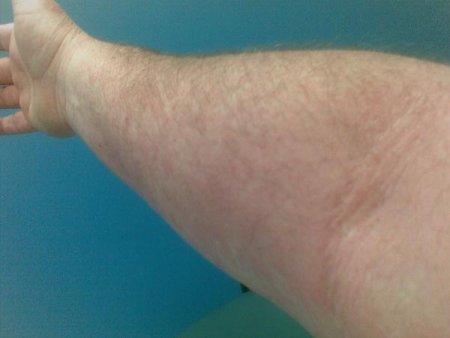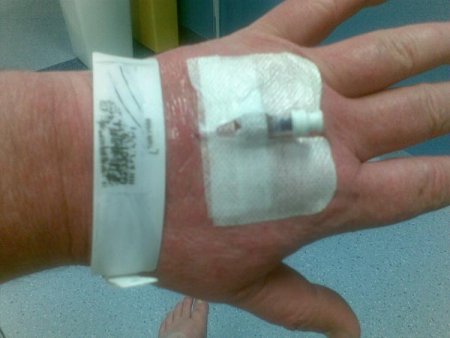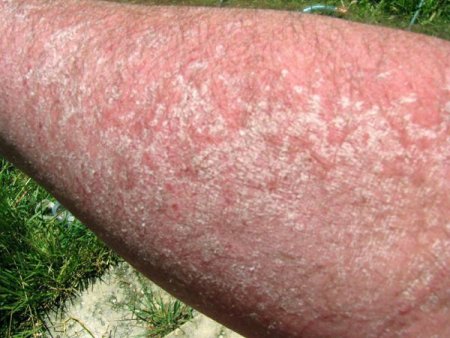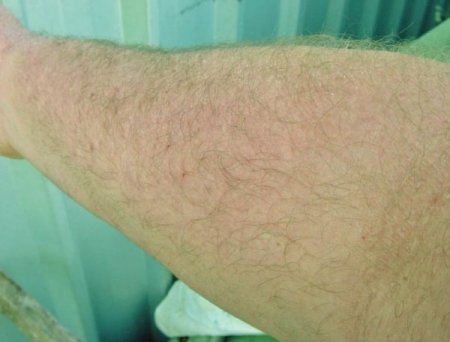|
Around seven or eight I had been at the
finishing stage of my build and was applying
Zpoxy to grain fill the EIR used for the body of
this instrument. In fact you may even recall a
tutorial I posted back around that time showing
how I use syringes to insure an equal mixture
when measuring out the small quantity required
when using this product.
The doctor done his rounds telling me that the
swelling in my leg was so bad it had restricted
circulation to such an extent as to prevent the
antibiotics from getting in there to do there
work. He said it could be some time before they
do the job and I would need to just lay down
with my legs raised for a week or so and let it
happen. Rather than have me take up a much
needed hospital bed, the doctor sent me home on
the “Hospital In The Home” program (HITH). This
would see me at home with an IV shunt still in
the back of my hand, and a HITH nurse come visit
me each day to inject antibiotics into the shunt
until the infection was bought under control.
The itch remained, the Phenergan continued
supplemented by codeine forte required to manage
a pre-existing back problem which, among other
things, restricts my ability to lay down for
extended periods. The nurse continued to visit
each day with her big horse syringe and the rash
continued to grow. After a few days I was sure
the antibiotics where having no affect
whatsoever. In my drugged out wanderings I made
my way to the PC and Googled “Epoxy Allergies”
and I came across this site.
I went down to see my GP to see if he would
euthanate me putting me out of my misery, the
itch, the itch, the itch, the itch. My doctor
took a look at my leg and immediately had the
exact same response as every other medical
practitioner who had examined me up to this
point he said “Oh my gosh!” I showed him my pdf
files and he agreed it was contact dermatitis.
He told my I was fortunate because on that day,
right across the road from his surgery was a
doctor by the name of Mr Kurt Gebaur who is a
specialist in industrial dermatology, and just
by chance or divine intervention, Dr Kurt was
doing his 1 day stop monthly round of my home
town. My doctor made a call and I went across to
see Dr Kurt who looked at my legs and said “Oh
my gosh!” that is quite a pair of legs you have
under those symmetrical erthematous eruptions,
how long have you been like this? I told him
just over two weeks. He shook his head and said
you poor bastard. He ask “Itchy?” He then looked
up at my face and seen Rpokim standing there and
immediately apologised. I told him of my visit
to hospital and the antibiotics. He shook his
head and said nothing but did ask the name of
the doctor who had diagnosed cellulitis at the
hospital.
As you can see this Prednisone is not overly
nice stuff but it is effective at what it does.
A demonstrate of how completely un-nice epoxy is
can be taken from the fact that after I stopped
taking the Prednisone, the itch and skin
condition came back however it was more
manageable. I did not want to take the roids
again because of the side affects already point
out, one of which is that you become a little
confused and I am not use to that, it does not
sit well with me and Rpokim comes to visit with
much less provocation than would normally be
required, and then there is the hassle in
shaking the roids off again which is an ordeal
in itself and according to wiki can even prove
fatal. I decided now the itch was manageable, I
would wait it out in milder discomfort until the
epoxy dissipates from my system, after what I
had been through in the previous 2 weeks before
the roids, I felt I could stand pretty much
anything……………………………….I waited………it got worse.
After a couple more weeks the rash was picking
up some real anger again, the itch was moving
toward high intensity, the skin began to peel
from the palm of my hands, between my fingers
and the soles of my feet, my legs began to blow
up and itch and I had to face the fact that this
thing aint done with me yet. I called my doctor,
he said jump back on the roids and come see me
in a few days and we’ll take a look, I said “Oh
my gosh!”
|
|
From my experience this is how it is. Much of the same info. |
|
I find the sanding dust from epoxy much less irritating itch-wise than from polyester. I prefer to use scrapers as much as possible, and sand by hand rather than machine as much as possible to reduce dust anyway. Itching from getting the dust on you isn't an allergic reaction. Epoxy sensitivity (or allergy) affects some people and
appears to not affect others. I've been working with it for 15 years and
havent had any effects, but then I'm careful not to get it on me. |
|
I have developed epoxy allergy, pretty bad. I have always
wore protection, but green epoxy dust got sucked under my Tyvek suit due to
arms motion when long-boarding amas. My upper torso got covered with red
rash and sores, which lasted a couple of months. I stopped building for a
couple of years.I am still building my F-82R (about half done), in winter,
since if I cannot sail, building is next best thing.Double layer protection
and a supplied air system. |
|
As an engineer with a masters in designing boats I've spent
far too much time in workshops that used epoxy. For this reason I probably
take for granted the fact that people using the stuff are aware of the
sensitivity issue, which is why I've never thought to post a warning when
reading posts about using it. I suspect this is a much bigger problem than
most people would be aware of, one workshop I worked in had three people
from a staff of ten who had to leave for day when they were going to be
spraying epoxy, and this was just because of the fumes from the spray booth
a good 50m away. One of the guys there after years using it for a decade
without a problem suddenly developed a sensitivity. It started with a rash
then one day feeling that he hadn't been near the stuff for months, he
walked into the booth to help out, within 10 min had blacked out. He ended
up in hospital on a respirator for 6 weeks and sickness benefits for life
after that due to the damage to his lungs. |
|
Inhaling the dusts and fumes associated with a long boat
building process should be vigorously avoided. Many/most fine dusts get
caught up in the lymphatic system around the lungs and stay around for a
long time causing problems like silicosis and cancers. Inhaled fumes
(evaporated solvents) cross into the bloodstream unhindered and from there
go to every organ of your body which can in turn cause liver and bladder
injuries and cancers among other things. Liver toxicity from inhaled
solvents is well known. The skin allergy to epoxy has been pretty well
described here. Fascinating accounts. It is a well known phenomenon in
allergy medicine that a person can have repeated exposures to an allergen
without triggering an immune response. Then one day, BANG, the immune system
suddenly and forever has a |
|
My brother warned me off of epoxy. About 4 years ago he
wanted to build a kayak. It was stitched together with copper wire and then
covered with epoxy. He had been working on it diligently for a while and
then stopped dead, never to go back to it. He was working with epoxy and
some how smeared a bit on his forehead when he wiped his face with his arm.
As soon as he realized what happened, he went in and washed. You can still
tell where the epoxy was. The skin is red and scaly. It comes and goes,
stays red for days on end. He's lucky. He had no clue that he should be
wearing a respirator. |
|
I'm heavily allergic to epoxy and it developed slowly over
time. At first it started out as a mild annoyance, but over time my symptoms
became more severe. |
|
I think I am going to have to shut down my store for I have
been having a severe allergic reaction to the epoxy resin that I use. I have
had my eyelids burnt badly to the point they almost swell shut, split open,
and then ooze liquid from the eyelids. I wear protective goggles, I am
ventilated, and also wear a respirator. I have used the resin for a year now
and just recently have had severe reaction to the resin. I even now have
rash on my fingers that itches and resembles poison ivy but I know it is
from the resin. I have tried dg3 gel, 3d lacquer, and diamond glaze. I am
not happy with the outcome of any of these items. If anyone can suggest
another non toxic resin I can use can you please let me know? |
|
The dust from carbon fiber work is extremely dangerous. When
inhaled, it impales itself to the workings of your lungs, preventing the
normal cleansing action, that phlegm and coughing it up would normally help
eliminate it. |
|
In general, the amines are causing most trouble. Try and
source an epoxy that is known to be more friendly to people, if you are
concerned. |
|
I thought I was being careful w/epoxy but in the end I
discovered I was not careful enough. I used nitrile gloves and wore reg
blue jeans and tennis (rubber) shoes. Occaisionally I would drip a spot
of epoxy on my jeans and did not notice so the glue hardened into the
jeans cloth. After working with it for a year I had to fair out my hull
and being in a hurry, I applied epoxy one day and sanded it down the
next w/o wearing a dust mask. I believe this is what done me in. My
whole body broke out in a severe red rash very similar to poison Ivy
rash. The itch was unbearable. I stayed away from epoxy for 2 weeks and
the rash went away. After that I was much more careful working with the
stuff. I wore a haz-mat suit along with my nitrile gloves but no
respirator. There are no fumes (zero) with West System epoxies. I waited
for the full 2 weeks cure time before sanding epoxy and wore no dust
mask. Fully cured epoxy is not toxic at all. I did not wear nitrile
gloves when sanding. If I got any sanding dust on my hands, I washed it
off w/soap & water witin 5 minutes. I have been working this way full
time for 4 additional years with no futher episodes of toxic exposure. I
have now completed my 50' sailing yacht and will be launching in approx
6 weeks. At the end of the day I would say do not fear epoxy; just
respect it and it will leave you work in peace. |
|
What a utter nonsense! |
|
1. Most people are not sensitive to epoxy. |
|
1. Correct. The funny thing is that native African
people (Negroides) usually are far more sensitive than Kaukasian people.
We found that out in the epoxy flooring industry. It was hard to keep
Negroide people, for the effect on their skin. (and no, this is not an
attempt to discriminate) |
|
For people that are not affected indeed it can be quite
astonishing. Allergic reactions can do strange things to people. |
|
I've developed a sensitivity to epoxy. I think it may be the Glen-L epoxy. I never had this issue with MAS or West. But I may have just become sensitized over the last year between the kayak and the Malahini. The Glen-L stuff definitely has a different smell than the others did.
My eyes get very itchy and then my eyelids get kinda raw on the outside (probably from rubbing). Then of course the skin gets dry and scaly. I am basically finished but have a couple of little things to do. I'm going to get some goggles and keep wearing my respirator. Does anyone else have any issues like that?
|
|
its weird....i have only a very slight allergy to West System. If i use it several days in a row, even with long sleeves and gloves, i start to get hives on my arms. Mostly, casual use ever few days or so causes nothing.
|
|
As many of you know I have become VERY sensitive to epoxy. Causes a poison ivy type rash on my hands that itch like crazy, eye lids crack and bleed, eyes blood shot and get big red blotches on my face. And all of this is with ZERO physical contact - for me it is just the fumes. And it does seem to be cumulative. The more often the exposure the worse the symptoms. If I haven't used any for several months I can get away with a small amount of usage. But is trying to use it on successive days it can get nasty if I don't take precautions. So here is do I do - I had a conversation with my doctor and asked him to prescribe “Flonase”. This is a nasal spray that is approved to treat the nasal symptoms of indoor and outdoor allergies. It was suggested by another builder with a similar problem and does seem to help. I also always wear a respirator with filter cartridges organic fumes. But for me the most effective measure is fresh air - LOTS of fresh air. I bought a big fan on a stand that blows like a hurricane. When ever I am using epoxy it have it blasting me and helping blow the fumes away. Also, I have a 3' exhaust fan in my shop and when I epoxy it runs 24/7 for at least a week after. When I do epoxy work I setup and do the job but then immediately exit the shop when done and don't return until the next day. I have also find that the dust from sanding epoxy causes me problems - even months later. Because of that I don't use a power sander with out a shop vac attached. For me the little built-in dust bags don't get it as they usually allow to much to escape. These methods may be extreme for many but are necessary for me. Doing the things above I was able to cover the exterior of my True Grit with epoxy but it was a challenge.
Also, keep in mind at first I wasn't allergic to epoxy and took few precautions but now pay for lack of respect of the stuff.
|
|
Again here I would like to mention MAS epoxy with their "LOW TOX'" hardener. It works for me. I know two woodworkers other than myself who have become sensitized, and believe me , when the body decides to, ( sometimes with little warning,) the reaction can and probably will be severe enough to require hospitalization.
|
|
I have seen workers who have developed contact dermatitis from working with certain chemical solvents like MEK and other organic solvents/compounds. There is considerable research on the topic of contact dermatitis from exposure to epoxy resins. Please be very careful working around both resins and dust. In the chem plant where I worked, I saw workers who developed spontaneous eruptions of oozing skin ulcers that lasted for weeks. The ulcers could appear anywhere, not just where contact had once occurred. Once the chemical sensitivity happened, these workers could no longer perform their jobs ---- and couldn't even remain in the building where the chemicals were used. Just exposure to the fumes (no contact) was enough to initiate production of skin ulcers. Very nasty. Dermatitis is a diagnosis that covers a wide range of symptoms and just means "inflamation of the skin." But the inflamation can take many forms, including red, itchy, patchy areas, flaking, blisters, ulcers (very nasty looking), etc. Because these symptoms are visible to others, they evoke a subconcious "avoid and do not approach or touch" response. Do not dismiss the threat lightly. I have seen people who live a degraded quality of life because their skin is constantly going "crazy" on them. Usually, an episode of dermatitis will heal over a period of days, especially when helped by treatment with topical steroids like betamethosone. But I have also known people whose dermatitis never goes away. Please take care when working with these compounds. Do not assume that because you have worked with it for years that you will never develop a chemical sensitivity to it, and resultant expression of the allergic reaction as some form of dermatitis. For most of us, there is a threshold limit for total lifetime exposure that once breached can result in a lifetime of nastiness, as many of these compounds are present in everyday materials that offgas to some extent. Like herpes, once you've got it, you've got it for life. Whenever I work with organic solvents/compounds where more than a few
minutes of exposure to fumes or dust, or contact with the chemicals themselves is
likely to occur, I use as appropriate a full face HEPA/carbon filter, full
body tyvek overalls, and chemical resistant gloves. Having occasional
episodes of dermatitis myself these days, I am VERY careful.
|
|
Epoxy IS dangerous and anyone that tells you otherwise
is equally |
|
The old "I've used it for years and it never hurt me" is a cliche for a reason. I've heard it so many times over the years, from issues regarding PCB's (from a friend whose face and arms were covered with melanoma removal scars--one of which eventually killed him), to owner-operator truckers driving 12-hr shifts--until they wrecked their rigs and became uninsurable, to non-union carpenters swinging "illegally" large hammers--then "retiring" at 35 or 40 due to debilitating arthritis. I worked a few years for a defense contractor who used a lot of epoxy for potting circuitry. The firm was known for hiring minorities--and not looking too closely at their papers. Less known was that they also routinely laid them off when they became sensitized to epoxy. I called a boss on it, who had the chutzpah to say, "Hey, they'll never work with epoxy after they go home, so will never have symptoms." Epoxy is very dangerous--as is its dust (due to un-catalyzed bits of both resin and hardener encapsulated in the matrix, on amateur mixes). It is (almost) always over-kill for an amateur-built boat, which was Derek's primary point, after all. The idea of building a plywood boat--to save on materials cost--and then covering it in expensive epoxy is an oxy-moron of the highest order when you think about it (though I've built half a dozen myself!) You'd have been so much better off building in glass/foam, by most any metric available--engineered strength, weight, cost, labor, safety--and resale value. Designing your entire work product--and all the decades-long downstream ramifications of that choice, based on a few hours--even a few tens of hours--of objectionable odors seems distinctly like mis-placed priorities to me--but that's only my opinion. If smell is an issue for you there are multiple solutions--from moving your shop to the hinterlands, to working solely with infusion (cool skill to add to your toolbox!), to building a paint booth-like filter system--to using epoxy. Life is a series of compromises and choices; this isn't a black and white issue. |
|
As far as I am aware cancer is not the problem – it is skin allergies Some are un affected, some like me are partially affected and others are massively affected You can’t predict… I have seem colleagues totally unaffected then start with an itch then end up with crusting open sores from exposure It would seem fast set hardeners are more allergenic than slow – and as many of you guys work in warm climates, I guess you use slow hardeners, here in damp cold UK… fast is common. Just reads the safety info on the labels – it makes sense to be
careful
|
|
I would like to provide my own experience over the last
20 years, in case it |
|
Once you have epoxy on your gloves, you WILL have an itch on your nose, your eyes WILL need to be rubbed, and you WILL begin to sweat and need to wipe your brow. More about safety and epoxy
here. |
|






